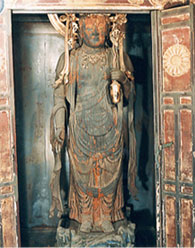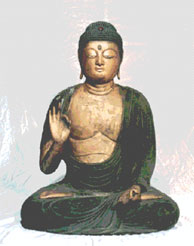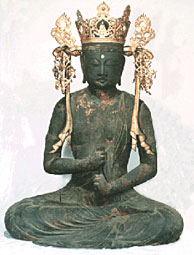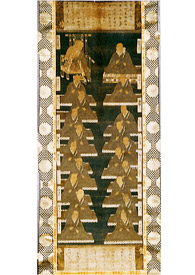|
|
| Travel |
| Osaka City Designated Cultural Assets in Higashiyodogawa Ward |
| Standing Wooden Statue of Eleven-faced Kannon Bodhisattva |  |
| With a face that is not clear-cut but
serene, this statue was carved from one piece of wood and has a stately
presence. On the chest part, one can see the Honbashiki Emon,
a depiction of folds that characterized sculptures in the first half
of the Heian Era (794 - 1192). As a wooden statue of seated Dainichi Nyorai (great sun tathagata), the Eleven-faced Kannon Bodhisattva is said to be one of the old Buddha statues worshipped at nearby Daijiin Sanpo Temple, which no longer exists. The statue was made sometime in the early to mid 11th century. *The statue is shown to visitors by request |
|
| For
more information, ask Sennenji (temple) Address: 3-5-15 Komatsu, Higashiyodogawa-ku Tel: 06-6320-1331 |
| Sitting Wooden Statue of Amida Nyorai (the Lord of Infinite Light) |  |
| This is the principal image of worship
at Sennenji Temple. A notable aspect of the statue is its rather small
and meek face on a thin upper body. It shows the early style of Jocho
(a sculptor of Buddhist images in mid-Heian Era) with a robust and
gallant figure. It is considered to have been made in the latter half
of the 11th century and is one of the major Jocho-style sculptures
of the Heian Era that still remains in Osaka City. Some say the statue
was made by the priest Eshin, a learned monk of the time. * The statue is shown to visitors by request |
|
| For
more information, ask Sennenji (temple) Address: 3-5-15 Komatsu, Higashiyodogawa-ku Tel: 06-6320-1331 |
| Sitting Wooden Statue of Dainichi Nyorai (great sun Tathagata) |  |
| This statue is said to have been the
principal image of worship at nearby Daijiin Sanpo Temple, which does
not exist anymore. Its gentle expression and mild presentment of wrinkles
show the features of Jocho style, of the latter half of the Heian
Era. Meanwhile, increased cadences of the facial features and a way
of extending the front part of the knees show the new breath of the
Kamakura Era (1180 - 1333). It is believed that the statue was made at the end of the 12th century, from the end of Heian to the beginning of the Kamakura Period. * The statue is shown to visitors by request |
|
| For more
information, ask Sennenji (temple) Address: 3-5-15 Komatsu, Higashiyodogawa-ku Tel: 06-6320-1331 |
| Kenhon Chakushoku Nihon Kechimyaku Soujo Shinei |  |
| It seems that originally,
this hanging scroll was owned by an adherent of the Bukkoji Temple
school of the Shin sect. On the back of the scroll, there is a certificate
of authenticity written by Rennyo, the 8th chief priest of Honganji
school, in 1463. This is a very important historical material that shows how the power of the Honganji school expanded, shifting over from the Bukkoji school, and became a big power called Nakajimashu. * It is not shown to the public, to prevent deterioration. |
|
| Address:
2-13-35 Kunijima, Higashiyodogawa-ku Tel: 06-6322-0582 |